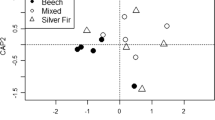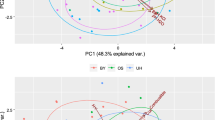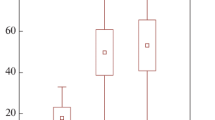Abstract
The impact of the admixture of beech in spruce monocultures on structure and function of the decomposer community was studies in the Ore mountains (Saxony, Germany) on Dystric Cambisols between 2000 and 2002. The study sites represented four stages of forest conversion from a mature spruce stand to a mature spruce/beech stand. There, the functional profile of the nematodes, enchytraeids, lumbricids, and dipterans was analysed on the basis of ecological guilds, and their metabolic equivalences were calculated to characterize the decomposition potential of the invertebrate decomposer community. Because of the acidic parent soil the coenoses at all study sites were dominated by the enchytraeids with increasing importance of lumbricids and dipterans in progress of forest conversion. Gradual changes with rising coverage of beech culminated in intense differences of entire biomasses and metabolic equivalences between the mature stands, indicating a higher decomposition potential of the invertebrate decomposer community by the admixture of beeches in spruce forests. The quality of the beech litter is likely to be the important factors for these changes. To prove this assumption further investigations of the saprovore food chain are necessary, taking microbial parameters into account.
Similar content being viewed by others
References
Abrahamsen G 1973 Studies on body-volume, body-surface area, density and live weight of Enchytraeidae (Oligochaeta). Pedobiologia 13, 6–15.
Alphei J 1994 Die freilebenden Nematoden von Buchenwäldern mit unterschiedlicher Humusform: Struktur der Gemeinschaften und Funktion in der Rhizosphäre der Krautvegetation. PhD Thesis, Göttingen, 165 pp.
Alphei J and Klages U 1997 Die Gemeinschaftsstruktur freilebender Bodennematoden in Rein-und Mischbeständen von Buche und Fichte auf Buntsandstein. Mitt. Dtsch. Bodenkundl. Gesellsch. 85, II, 461–464.
Bååth E, Frostegard A, Pennanen T and Fritze H 1995 Microbial community structure and pH response in relation to soil organic matter quality in wood-ash fertilized, clear-cut or burned coniferous forest soils. Soil Biol. Biochem. 27, 229–240.
Baermann G 1917 Eine einfache Methode zur Auffindung von Ankylostomum (Nematoden)-Larven in Erdproben. Meded. Geneesk. Lab. Weltevreden 17, 41–47.
Blair J M and Crossley D A 1988 Litter decomposition, nitrogen dynamics and litter arthropods in a southern Appalachian hardwood forest 8 years following clearcutting. J. Appl. Ecol. 25, 683–698.
Bouché M B 1977 Strategies lombiriciennes. Ecol. Bull. 25, 122–132.
Brandtberg P O, Lundkvist H and Bengtsson J 2000 Changes in forest-floor chemistry caused by a birch admixture in Norway spruce stands. Forest Ecol. Manage. 130, 253–264.
Cadisch G and Giller K E (Eds.) 1997 Driven by Nature – Plant Litter Quality and Decomposition. CAB International, Wallingford, Oxon, UK, 405 pp.
Covington W W 1981 Changes in forest floor organic matter and nutrient content following clear cutting in northern hardwoods. Ecology 62, 41–48.
Dunger W 1978 Parameter der Bodenfauna in einer Catena von Rasen-Ökosystemen. Pedobiologia 18, 310–340.
Dunger W and Fiedler H-J 1997 Methoden der Bodenbiologie. 2nd ed., Gustav Fischer Verlag, Jena, 539 pp.
Frazer D W, McColl J G and Powers R F 1990 Soil nitrogen mineralisation in a clearcut chronosequence in a northern California conifer forest. Soil Sci. Soc. Am. J. 54, 1145–1152.
Funke W 1971 Food and energy turnover of leaf-eating insects and their influence on primary production. In Integrated Experimental Ecology. Methods and Results of Ecosystem Research in the German Solling Project. Ed. H Ellenberg. pp. 81–93. Springer, New York.
Garay I and Hafidi N 1990 Study of a mixed forest litter of horn-beam (Carpinus betulus L.) and oak (Quercus sessiliflora Smith)-III. Organization of the edaphic macroarthropod community as a function of litter quantity. Acta Oecol. 11, 43–60.
Graefe U and Schmelz R M 1999 Indicator values, strategy types and life forms of terrestrial Enchytraeidae and other microannelids. Newslett. Enchytraeidae 6, 59–67.
Gretschy G 1952 Die Sukzession von Bodentieren auf Fichtenschlägen. Veröff. Bundesanst. Landw. Admont 6, 25–85.
Heinze M, Tomczyk S and Nicke A 2001 Comparison of beech (Fagus sylvatica L.) in so-called Green Eyes with neighbouring spruce stands (Picea abies [L.] KARST.) in the Thuringian Vogtland country concerning soil quality, tree root density and tree growth. Ger. J. For. Sci.120, 139–153.
Heitz R 1998 Umbau von Fichtenreinbeständen in naturnahe Mischwälder-Auswirkungen auf bodenchemischen Zustand und Bioelementhaushalt. PhD Thesis, München, 307 pp.
Hövemeyer K 1985 Die Zweiflügler (Diptera) eines Kalkbuchenwaldes: Lebenszyklen, Raum-Zeit-Muster und Nahrungsbiologie. PhD Thesis, Göttingen, 280 pp.
Hövemeyer K 1992 Response of Diptera populations to experimentally modified leaf litter input in a beech forest on limestone. Pedobiologia 36, 35–49.
Hövemeyer K 1999 Abundance patterns in terrestrial dipteran communities. Pedobiologia 43, 28–43.
Hövemeyer K 2000 Ecology of Diptera. In Manual of Palaearctic Diptera. Volume 1: General and applied dipterology. Eds. L Papp and B Darvas. pp. 437–489, Science Herald, Budapest.
Huhta V 1976 Effects of clear-cutting on numbers, biomass and community respiration of soil invertebrates. Ann. Zool. Fenn. 13, 63–80.
Huhta V, Karppinen E, Nurminen M and Valpas A 1967 Effect of silvicultural practices upon arthropods, annelid and nematode populations in coniferous forest soil. Ann. Zool. Fenn. 4, 87–145.
Huhta V, Nurminen M and Valpas A (1969): Further notes on the effect of silvicultural practices upon the fauna of coniferous forest soil. Ann. Zool. Fenn. 6, 327–334.
Hyvönen R and Huhta V 1989 Effects of lime, ash and nitrogen fertilizers on nematode populations in Scots Pine forest soils. Pedobiologia 33, 129–143.
Hyvönen R, Andersson S, Clarholm M and Persson T 1994 Effects of lumbricids and enchytraeids on nematodes in limed and unlimed coniferous mor humus. Biol. Fertil. Soils 17, 201–205.
Jaschhof M 1998 Revision der Lestremiinae (Diptera, Cecidomyiidae) der Holarktis. Stud. dipt. Suppl. 4, 1–522.
Judas M 1990 The development of earthworm populations following manipulation of the canopy leaf litter in a beechwood on limestone. Pedobiologia 34, 247–255.
Kautz G and Topp W 1998 Sustainable forest management for improving soil quality. Ger. J. For. Sci. 117, 23–43.
Kazda M and Pichler M 1998 Priority assessment for conversion of Norway spruce forests through introduction of broadleaf species. Forest Ecol. Manage. 102, 245–258.
Kempson D, Lloyd M and Ghelardi R 1963 A new extractor for woodland litter. Pedobiologia 3, 1–21.
La France, M. 2002 Zu den Auswirkungen experimenteller Waldneugründungs-und Waldumbaumaßnahmen auf die saprophage Invertebratenfauna an extrem immissionsgeschädigten Kammlagenstandorten des Osterzgebirges (Sachsen). PhD Thesis, TU Dresden, 197 pp.
Lundkvist H 1983 Effects of clear-cutting on the enchytraeids in a Scots Pine forest soil in central Sweden. J. Appl. Ecol. 20, 873–885.
MacFadyen A 1961 Improved funnel-type extractors for soil arthropods. J. Anim. Ecol. 30, 171–184.
Mikola J, Bardgett R D and Hedlund K 2002 Biodiversity, ecosystem functioning and soil decomposer food webs. In Biodiversity and Ecosystem Functioning. Eds. M Loreau, S Naeem and P Inchausti. pp. 169–180. Oxford University Press, Oxford.
O'Connor F B 1962 The extraction of Enchytraeidae from soil. In Progress in Soil Zoology. Ed. P W Murphy. pp. 279–285. Butterworth, London.
Persson T 1988 Effects of liming on the soil fauna in forests – a literature review. Statens naturvardsverk, Rapport 3418, Solna, 92 pp.
Persson T and Lohm U 1977 Energetical significance of the annelids and arthropods in a swedish grassland soil. Ecol. Bull. 23, 211 pp.
Ponge J F and Delhaye L 1995 The heterogeneity of humus profiles and earthworm communities in a virgin beech forest. Biol. Fert. Soils 20, 24–32.
Ponge J F, Arpin P, Sondag F and Delecour F 1997 Soil fauna and site assessment in beech stands of the Belgian Ardennes. Can. J. For. Res. 27, 2053–2064.
Räty M and Huhta V 2003 Earthworms and pH affect communities of nematodes and enchytraeids in forest soil. Biol. Fert. Soils 38, 52–58.
Rehfuess K E 1990 Waldböden – Entwicklung, Eigenschaften und Nutzung. 2nd ed. Parey, Hamburg, 283 pp.
Schaefer M 1996 Die Bodenfauna von Wäldern: Biodiversität in einem ökologischen System. Franz Steiner Verlag, Stuttgart, 81 pp.
Scheu S 1989 Die saprophage Makrofauna (Diplopoda, Isopoda und Lumbricidae) in Lebensräumen auf Kalkgestein: Sukzession und Stoffumsatz. PhD Thesis, Göttingen, 302 pp.
Scheu S, Albers D, Alphei, J, Buryn R, Klages K, Migge S, Platner C and Salamon J-A 2003 The soil fauna community in pure and mixed stands of beech and spruce of different age: Trophic structure and structuring forces. Oikos 101, 225–238.
Schröter D, Wolters V and De Ruiter P C 2003 C and N mineralisation in the decomposer food webs of a European forest transect. Oikos 102, 294–308.
Sharon R, Degani G and Warburg M 2001 Comparing the soil macro-fauna in two oak-wood forests: Does community structure differ under similar ambient conditions? Pedobiologia 45, 355–366.
Skambracks D 1996 Die Bedeutung saprophager Regenwürmer im Nährstoffkreislauf von Waldböden. PhD Thesis, Köln, 174 pp.
Smolander A, Priha O, Paavolainen L, Steer B and Malkonen J 1998 Nitrogen and carbon transformations before and after clear-cutting in repeatedly N-fertilized and limed forest soil. Soil Biol. Biochem. 30, 477–490.
Swift M J, Heal O W and Anderson J M 1979 Decomposition in terrestrial ecosystems. Blackwell Scientific Publications, Oxford, 372 pp.
Theenhaus A and Schaefer M 1995 The effects of clear-cutting and liming on the soil macrofauna of a beech forest. For. Ecol. Manage. 77, 35–51.
Wardle, D A 2002 Communities and ecosystems: linking the above-ground and belowground components. Monogr. Pop. Biol. 34, Princeton University Press, Princeton, 392 pp.
Wolters V 2000 Invertebrate control of soil organic matter stability. Biol. Fertil. Soils 31, 1–19.
Woodcock B A, Watt A D and Leather S R 2003 Influence of management type on Diptera communities of coniferous plantations and deciduous woodlands. Agri. Ecosys. Environ. 95, 443–452.
Yeates G W, Bongers T, Degoede R G M, Freckman D W and Georgieva S S 1993 Feeding habits in soil nematode families and genera – An outline for soil ecologists. J. Nematol. 25, 315–331.
Author information
Authors and Affiliations
Rights and permissions
About this article
Cite this article
Elmer, M., La France, M., Förster, G. et al. Changes in the decomposer community when converting spruce monocultures to mixed spruce/beech stands. Plant Soil 264, 97–109 (2004). https://doi.org/10.1023/B:PLSO.0000047776.86805.0f
Issue Date:
DOI: https://doi.org/10.1023/B:PLSO.0000047776.86805.0f




